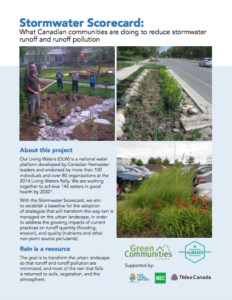As British Columbian families evacuate their homes amidst out of control wildfires, news of toxic algae blooms in Canadian lakes and oceans spread. Both coming shortly on the heels of spring rains which caused floods in communities across the country. There’s no doubt that climate change is starting to bite, and it’s using water as its teeth. Water challenges – whether it be too little, too toxic, or too much – cost our communities significantly. How do we ready our homes, towns, regions for whatever wacky weather patterns the future holds?
A recent initiative of OLW members Green Communities Canada and the Canadian Freshwater Alliance assessed communities across the country on their adoption of green infrastructure policies and projects (see scorecard summary). Unfortunately, the assessment found few communities have advanced beyond pilot projects for green infrastructure and none have reached a transformative stage where the majority of rainwater falling in the community would be absorbed where is falls, decreasing runoff and runoff pollution.

Green infrastructure includes using rain gardens, bioswales, wetlands, and other natural green developments to absorb rainwater where it falls – reducing flood risk, minimizing runoff pollution (including sewage overflows) and decreasing pressure on aging grey and sewer infrastructure.
If green infrastructure has so many benefits, why has uptake been so slow? And how can we, across the freshwater community, promote broader adoption?
One might say the problem is inertia. We have been building our cities in a particular way for decades (even centuries). Cities are designed to take water and funnel it away through sewer systems. The change to manage water where it falls requires a transformational shift in how we build our communities. Cities like Vancouver and Thunder Bay are beginning to embrace this challenge, integrating specific targets into city planning documents – like stormwater or rainwater master plans.
We need communities across Canada to follow the lead of Vancouver and Thunder Bay. We need to propel innovation in urban design and drive public support to not only revitalize our existing communities with greenery, but to also require and incentivize new developments to embrace green infrastructure approaches. But, to get there, we need more communities striving for excellence in green infrastructure implementation.
What ideas do you have to help Canadian cities turn the curve on transforming stormwater management?